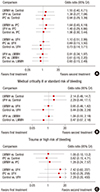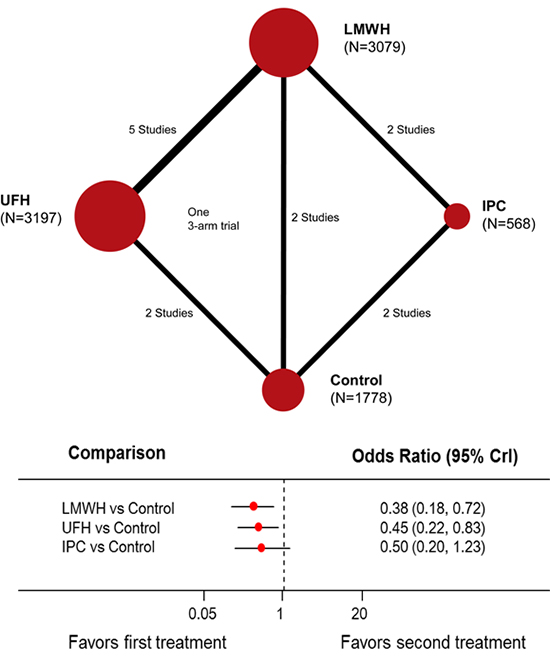1. Moser KM, LeMoine JR, Nachtwey FJ, Spragg RG. Deep venous thrombosis and pulmonary embolism. Frequency in a respiratory intensive care unit. JAMA. 1981; 246:1422–1424.
2. Geerts W, Cook D, Selby R, Etchells E. Venous thromboembolism and its prevention in critical care. J Crit Care. 2002; 17:95–104.
3. Cook DJ, Donadini MP. Pulmonary embolism in medical-surgical critically ill patients. [vii.]. Hematol Oncol Clin North Am. 2010; 24:677–682.
4. Kahn SR, Lim W, Dunn AS, Cushman M, Dentali F, Akl EA, Cook DJ, Balekian AA, Klein RC, Le H, et al. Prevention of VTE in nonsurgical patients: antithrombotic therapy and prevention of thrombosis, 9th ed: American college of chest physicians evidence-based clinical practice guidelines. Chest. 2012; 141:e195S–e226S.
5. Alhazzani W, Lim W, Jaeschke RZ, Murad MH, Cade J, Cook DJ. Heparin thromboprophylaxis in medical-surgical critically ill patients: a systematic review and meta-analysis of randomized trials. Crit Care Med. 2013; 41:2088–2098.
6. Kakkos SK, Caprini JA, Geroulakos G, Nicolaides AN, Stansby GP, Reddy DJ. Combined intermittent pneumatic leg compression and pharmacological prophylaxis for prevention of venous thromboembolism in high-risk patients. Cochrane Database Syst Rev. 2008; CD005258.
7. Silbersack Y, Taute BM, Hein W, Podhaisky H. Prevention of deep-vein thrombosis after total hip and knee replacement. Low-molecular-weight heparin in combination with intermittent pneumatic compression. J Bone Joint Surg Br. 2004; 86:809–812.
8. Eisele R, Kinzl L, Koelsch T. Rapid-inflation intermittent pneumatic compression for prevention of deep venous thrombosis. J Bone Joint Surg Am. 2007; 89:1050–1056.
9. Lauzier F, Turgeon AF, Boutin A, Shemilt M, Côté I, Lachance O, Archambault PM, Lamontagne F, Moore L, Bernard F, et al. Clinical outcomes, predictors, and prevalence of anterior pituitary disorders following traumatic brain injury: a systematic review. Crit Care Med. 2014; 42:712–721.
10. Zhang C, Zeng W, Zhou H, Zheng BX, Cheng JC, Li XY, Jiang YP, Jiang LD, Li XJ. The efficacy of intermittent pneumatic compression in the prevention of venous thromboembolism in medical critically ill patients. Zhongguo Wei Zhong Bing Ji Jiu Yi Xue. 2011; 23:563–565.
11. Vignon P, Dequin PF, Renault A, Mathonnet A, Paleiron N, Imbert A, Chatellier D, Gissot V, Lhéritier G, Aboyans V, et al. Intermittent pneumatic compression to prevent venous thromboembolism in patients with high risk of bleeding hospitalized in intensive care units: the CIREA1 randomized trial. Intensive Care Med. 2013; 39:872–880.
12. Egger M, Zellweger-Zähner T, Schneider M, Junker C, Lengeler C, Antes G. Language bias in randomised controlled trials published in English and German. Lancet. 1997; 350:326–329.
13. Higgins JP, Green S. Cochrane handbook for systematic reviews of interventions version 5.1.0 [Internet]. updated March 2011. accessed on 4 September 2016. Available at
http://handbook.cochrane.org.
14. Jadad AR, Moore RA, Carroll D, Jenkinson C, Reynolds DJ, Gavaghan DJ, McQuay HJ. Assessing the quality of reports of randomized clinical trials: is blinding necessary? Control Clin Trials. 1996; 17:1–12.
15. Lumley T. Network meta-analysis for indirect treatment comparisons. Stat Med. 2002; 21:2313–2324.
16. Gelman A, Rubin DB. Inference from iterative simulation using multiple sequences. Stat Sci. 1992; 7:457–472.
17. Moher D, Liberati A, Tetzlaff J, Altman DG. PRISMA Group. Preferred reporting items for systematic reviews and meta-analyses: the PRISMA statement. Ann Intern Med. 2009; 151:264–269. W64
18. Geerts WH, Jay RM, Code KI, Chen E, Szalai JP, Saibil EA, Hamilton PA. A comparison of low-dose heparin with low-molecular-weight heparin as prophylaxis against venous thromboembolism after major trauma. N Engl J Med. 1996; 335:701–707.
19. Cook D, Meade M, Guyatt G, Walter S, Heels-Ansdell D, Warkentin TE, Zytaruk N, Crowther M, Geerts W, Cooper DJ, et al. Dalteparin versus unfractionated heparin in critically ill patients. N Engl J Med. 2011; 364:1305–1314.
20. Cade JF. High risk of the critically ill for venous thromboembolism. Crit Care Med. 1982; 10:448–450.
21. Goldhaber SZ, Kett DH, Cusumano CJ, Kuroki CA. Low molecular weight heparin versus minidose unfractionated heparin for prophylaxis against venous thromboembolism in medical intensive care unit patients: a randomized controlled trial. J Am Coll Cardiol. 2000; 35:A325.
22. De A, Roy P, Garg VK, Pandey NK. Low-molecular-weight heparin and unfractionated heparin in prophylaxis against deep vein thrombosis in critically ill patients undergoing major surgery. Blood Coagul Fibrinolysis. 2010; 21:57–61.
23. Fraisse F, Holzapfel L, Couland JM, Simonneau G, Bedock B, Feissel M, Herbecq P, Pordes R, Poussel JF, Roux L, et al. Nadroparin in the prevention of deep vein thrombosis in acute decompensated COPD. Am J Respir Crit Care Med. 2000; 161:1109–1114.
24. Ginzburg E, Cohn SM, Lopez J, Jackowski J, Brown M, Hameed SM; Miami Deep Vein Thrombosis Study Group. Randomized clinical trial of intermittent pneumatic compression and low molecular weight heparin in trauma. Br J Surg. 2003; 90:1338–1344.
25. Kapoor M, Kupfer YY, Tessler S. Subcutaneous heparin prophylaxis significantly reduces the incidence of venous thromboembolic events in the critically ill. Crit Care Med. 1999; 27:A69.
26. Shorr AF, Williams MD. Venous thromboembolism in critically ill patients. Observations from a randomized trial in sepsis. Thromb Haemost. 2009; 101:139–144.
27. Kurtoglu M, Yanar H, Bilsel Y, Guloglu R, Kizilirmak S, Buyukkurt D, Granit V. Venous thromboembolism prophylaxis after head and spinal trauma: intermittent pneumatic compression devices versus low molecular weight heparin. World J Surg. 2004; 28:807–811.
28. Limpus A, Chaboyer W, McDonald E, Thalib L. Mechanical thromboprophylaxis in critically ill patients: a systematic review and meta-analysis. Am J Crit Care. 2006; 15:402–410.
29. Lamontagne F, McIntyre L, Dodek P, Heels-Ansdell D, Meade M, Pemberton J, Skrobik Y, Seppelt I, Vlahakis NE, Muscedere J, et al. Nonleg venous thrombosis in critically ill adults: a nested prospective cohort study. JAMA Intern Med. 2014; 174:689–696.
30. Lachmann EA, Rook JL, Tunkel R, Nagler W. Complications associated with intermittent pneumatic compression. Arch Phys Med Rehabil. 1992; 73:482–485.
31. Won SH, Lee YK, Suh YS, Koo KH. Extensive bullous complication associated with intermittent pneumatic compression. Yonsei Med J. 2013; 54:801–802.
32. Siddiqui AU, Buchman TG, Hotchkiss RS. Pulmonary embolism as a consequence of applying sequential compression device on legs in a patient asymptomatic of deep vein thrombosis. Anesthesiology. 2000; 92:880–882.









 PDF
PDF ePub
ePub Citation
Citation Print
Print





 XML Download
XML Download